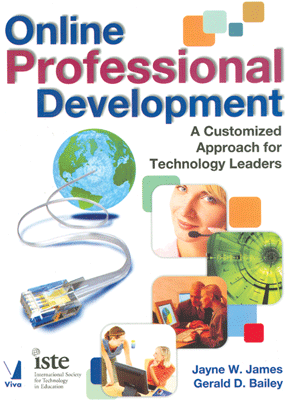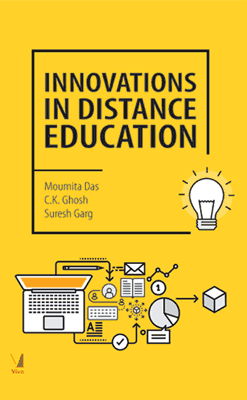
Online Professional Development
Online Professional Development
A Customized Approach for Technology Leaders
₹355.50 ₹395.00 Save: ₹39.50 (10%)
Go to cartISBN: 9788130909097
Bind: Paperback
Year: 2009
Pages: 312
Size: 216 x 280 mm
Publisher: International Society for Technology in Education (Eurospan Group)
Published in India by: Viva Books
Exclusive Distributors: Viva Books
Sales Territory: India, Nepal, Pakistan, Bangladesh, Sri Lanka
Description:
Now widely accepted as a viable medium for learning, the Internet is one of the most common instructional technologies used in elementary and secondary classrooms. This singular guide proposes that the Internet can similarly revolutionize teacher training. In fact, the authors and experts who participated in the development of this guide see the Internet as an open invitation for professional development journeys that can meet the unique needs of any learning community. Each of the guide's six sections includes an overview, step-by-step explanation, examples to reinforce concepts, and resources to assist with planning, knowledge gathering, and implementation. The process is systematic, blending strategies, methods and tools for efficiency and flexibility. With nothing more than interest, use of the Internet, and this guide, you can develop an online learning program that will quickly become an important and strategic partner in your school or district's improvement and reform efforts.
Five Great Reasons for Teachers, Staff Developers and Administrators to Have This Guide
- Moves professional development beyond the one-size-fits-all model traditionally used by schools with tight budgets and limited time for teacher training
- Correlates to ISTE's NETS for Teachers and the National Staff Development Council (NSCD) Standards
- Provides an innovative Rapid Research section that will save time in grant writing, workshop development, report writing, work validation, and other projects requiring supporting data
- Includes ample appendixes with completed process guides for rural an urban school districts, a glossary, and a bibliography for more in-depth study
- Includes a CD-ROM with process guide templates.
FEATURES: Contains materials or ideas that are useful for higher education courses, inservice workshops, and other teacher training ? Uses the Internet to teach
Target Audience:
Teachers, technology coordinators, staff developers, principles, government education administrators.
Contents:
Points to ponder • A guide to this book's icons • Before you begin • Tips for using this guide • Section 1 - Realizing the Potential of Online Learning • Overview • Nuts and Bolts • Help with Process Guides • Assemble a team • Determine Assets and Liabilities • Investigate Current Professional Development Activities • Target an Activity for Online Professional Development • Summarize Potential Benefits to Learning in an Online Environment • Show and Tell • Section 2 - Developing a Customized Needs Analysis • Overview • Nuts and Bolts • Target learners and Content • Determine a knowledge base • Create a Rubric or Needs assessment survey • Map the learning path through learning tasks • develop a resource inventory • Show and Tell • Section 3 - Developing a Meaning Learning Activity • Overview • Nuts and Bolts • Design the Instructional Environment • Create the learning portal and activity structure • Establish a system for communication • Integrate content • Embed Assessment • Show and Tell • Section 4 - Pursuing the Right Product for the Task • Overview • Nuts and Bolts • Consider Environment, Time and Development • Explore Data Mining and Standard Issues • Investigate Web Page Authoring and Graphics • Explore Interactivity, Animation, and Screen Navigation • Investigate Digital Content • Show and Tell • Section 5 - Developing Effective Learning Paths • Overview • Nuts and Bolts • Establish Vision, Mission, and Goal Statement • Develop Objectives and Outcomes • Clarify Teams and Tasks • Connect and Communicate • Jump-Start the action plan • Fund and staff the project • Show and Tell • Section 6 - Measuring the Effect of Learning • Overview • Nuts and Bolts • Explore Audiences and Decision-Making Responsibilities • Ask the Right Questions and Cite Evidence • Acknowledge Deliverables and Benchmarks • Practice Data-Driven Decision making and Promote Ongoing Communication • Analyze Artifacts • Operationalize the Effort • Show and Tell
About the Authors:
Dr. Jayne W. James works as an associate director with ALTec, Advanced Learning Technologies, at the University of Kanasa. She currently serves as a director of the High Plains Regional Technology in Education Consortia (HPR*TEC), of the 21st Century Chautauqua, and of PT3.org, a group associated with the Preparing Tomorrow's Teachers to Use Technology initiative.
Dr. James has integrated technology into teaching at all levels of education, elementary through graduate classes. In addition to teaching, she has been involved in multiple professional development projects at regional, state, and national levels. Dr. James founded TAKE, Technology Assistance for Kanasa State Department of Education. She received her doctorate from Kanasa State University I 2000, with an emphasis in administrative and technology leadership.
Dr. Gerald D. Bailey is professor of educational administration and leadership in the College of Education at Kanasa State University. He received his doctorate from the University of Nebraska in 1972. His specialties are technology leadership and staff development. Prior to earning his doctorate, he worked as a teacher, lead teacher, and supervisor in the Lincoln Public Schools in Lincoln, Nebraska.
Dr. Bailey is the author of more than 200 journal articles, nine books, and several book chapters on technology leadership and staff development. His most recent book is 101 Tips, Traps and To-Dos for Creating Teams, published by the National Educational Service.
Dr. Bailey is past executive director of the Kansas Association of Supervision and Curriculum Development. In addition, he has consulted with businesses and schools throughout the United States and world.






